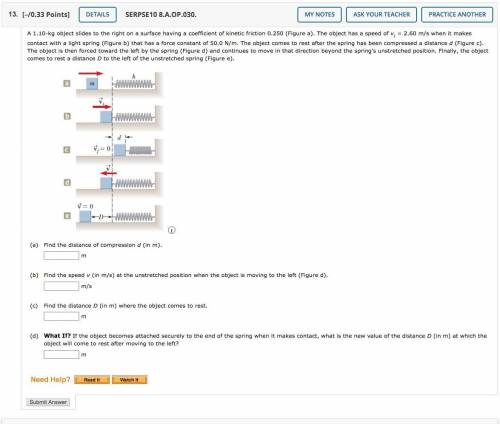
Physics, 16.10.2020 06:01, sashllely6112
A 1.10-kg object slides to the right on a surface having a coefficient of kinetic friction 0.250 (Figure a). The object has a speed of vi = 2.60 m/s when it makes contact with a light spring (Figure b) that has a force constant of 50.0 N/m. The object comes to rest after the spring has been compressed a distance d (Figure c). The object is then forced toward the left by the spring (Figure d) and continues to move in that direction beyond the spring's unstretched position. Finally, the object comes to rest a distance D to the left of the unstretched spring (Figure e).
The right end of a horizontal spring labeled k is attached to a wall. Five images show five configurations as a block labeled m approaches, compresses, and then moves away from the spring.
In figure a, the block is to the left of the spring, and an arrow above the block points to the right.
In figure b, the block is just touching the uncompressed spring, and an arrow labeled vector vi above the block points to the right.
In figure c, the block has compressed the spring by a distance d, and a label indicates vector vf = 0.
In figure d, the block is just touching the uncompressed spring, and an arrow labeled vector v above the block points to the left.
In figure e, the block is a distance D away from the spring, and a label indicates vector v = 0.
(a)
Find the distance of compression d (in m).
m
(b)
Find the speed v (in m/s) at the unstretched position when the object is moving to the left (Figure d).
m/s
(c)
Find the distance D (in m) where the object comes to rest.
m
(d)
What If? If the object becomes attached securely to the end of the spring when it makes contact, what is the new value of the distance D (in m) at which the object will come to rest after moving to the left?
m


Answers: 3
Other questions on the subject: Physics

Physics, 21.06.2019 23:30, reeseebaby89
You and a friend (alex) are at a a tree-top adventure park .. . part of the course requires you to climb up a rope. you both climb the same rope in the same amount of time. however, the tension in the rope is greater when alex climbs. who did the most work? alex did - more tension means more force - more force means more work was done you did - less tension means less force - less force means more work was done to find the work done, the force exerted and distance moved are multiplied. a couch is moved twice before you are happy with its placement. the same force was used to move the couch both times. if more work is done the first time it is moved, what do you know about the distance it was moved? when more work was done, the couch was moved less. when more work was done, the couch was moved further. when more work was done, the couch wasn't moved at all. when more work was done, the couch was moved the same distance.
Answers: 2

Physics, 22.06.2019 17:10, kaiyakunkle
What causes the development of most clouds and precipitation in the atmosphere?
Answers: 1

Physics, 22.06.2019 20:00, maciemarklin79981
Positive ions differ from neutral atoms in that
Answers: 3

Physics, 22.06.2019 23:00, katelynn73
Amother used 150 watts of power to raise a 15 newton object in a time interval of 8.0 seconds. through what vertical distance was the object raised ?
Answers: 1
Do you know the correct answer?
A 1.10-kg object slides to the right on a surface having a coefficient of kinetic friction 0.250 (Fi...
Questions in other subjects:

Mathematics, 15.07.2021 14:00

Mathematics, 15.07.2021 14:00

Arts, 15.07.2021 14:00


Chemistry, 15.07.2021 14:00

Mathematics, 15.07.2021 14:00

English, 15.07.2021 14:00

Chemistry, 15.07.2021 14:00


Biology, 15.07.2021 14:00


 = 2.60 m/s
= 2.60 m/s
 = W × μ
= W × μ


 = 25·d²
= 25·d² = 1.10×9.81×0.250×d = 2.69775·d
= 1.10×9.81×0.250×d = 2.69775·d
 .
. .
. .
. .
. denote the mass of the block. Let
denote the mass of the block. Let  denote the constant of kinetic friction between the object and the surface. Let
denote the constant of kinetic friction between the object and the surface. Let  denote the constant of gravitational acceleration.Let
denote the constant of gravitational acceleration.Let  denote the spring constant of this spring.(a)
denote the spring constant of this spring.(a) .
. and compressed the spring by the same distance.
and compressed the spring by the same distance.  . Elastic potential energy that the spring has gained:
. Elastic potential energy that the spring has gained:  .
. .
. . In the equation above, all symbols other than
. In the equation above, all symbols other than  .
. .
. .
. .
. is
is  .
. .
. because the energy lost to friction should be greater than zero.
because the energy lost to friction should be greater than zero. .
. .
. .
. .
. .
. ) would be lost to friction.
) would be lost to friction. .
. .
. .
. .
. .
. 



